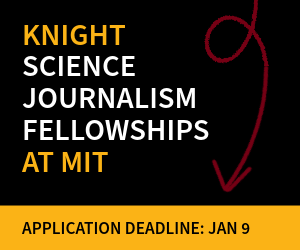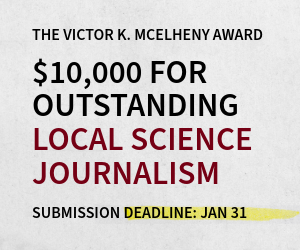During the ScienceWriters2014 meeting, Amber Dance and Dennis Meredith were awarded the annual Diane McGurgan Service award, which recognizes outstanding volunteer contributions to the National Association of Science Writers. The award is named after NASW's former executive director Diane McGurgan. Amber and Dennis co-chair the Science in Society Journalism Awards program. Read more to learn about their contributions to NASW.
Science writing news
Cheap and easy blogging tools have given campus news offices the ability to self-publish some of the research news that has been increasingly difficult to place in the mainstream media. But when the media relations team at Stanford University School of Medicine started talking about launching a blog in 2008, they decided to go one step further and publish news not only of their campus, but general health and medicine news, including developments at other schools.
The winners of travel fellowships to ScienceWriters2014 were asked to file reports on many of the conference sessions, and we've begun posting them on our conference reports page. More reports will be posted as they become available, so keep returning to that page over the next few days. And don't forget to mark your calendars now for ScienceWriters2015, October 9-13 in Cambridge, Mass.
It is with sadness that we share the announcement of ScienceOnline’s dissolution. The ScienceOnline organization's ideas and energy have been an inspiration to science writers and made a significant and lasting contribution to communicating science in the digital world. Reaction from Paul Raeburn, Pascale H. Lane. Storify from Kirk Englehardt.
Thanks to the hard work of two talented Japanese PIOs, the scientists’ guide Working with Public Information Officers has been translated into Japanese and is available online (WorkingWithPIOs.com). Besides being enormously gratifying to have his work translated, the process taught author Dennis Meredith a lot about the challenges of spreading the word internationally about the value and importance of PIOs, and how scientists can best work with them.
A science café is any deliberately planned event in a public setting where people gather with a “discussion leader” to learn and talk about science in their lives. This format of science communication began to take off in England and France at the turn of the millennium and now can be found in hundreds of locations around the world. Ivan Amato discusses the birth of the D.C. Science Café.
Six articles by NASW members are among the 26 works selected for inclusion in The Best American Science and Nature Writing 2014 by guest editor and NASW member Deborah Blum.
Her late mother’s 1963 travel diary inspired Jane Stein’s children’s book, presented as letters from a teacher to her students: Dear Class: Traveling Around the World with Mrs. J.
New York Times reporter Elisabeth Rosenthal, a physician and newspaper correspondent for 20 years, is the recipient of the 2014 Victor Cohn Prize for Excellence in Medical Science Reporting. Rosenthal will receive a $3,000 award and certificate at a ceremony in Columbus, Ohio, on Saturday, October 18, to be held during ScienceWriters2014, a meeting jointly organized by CASW and the National Association of Science Writers (NASW).



